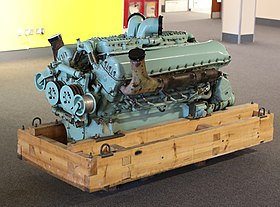| Rolls-Royce Meteor | |
|---|---|
 Rolls-Royce Meteor Mark III at The Tank Museum | |
| Overview | |
| Manufacturer | Rolls-Royce Limited Meadows Rover Morris Motors |
| Also called | Rover Meteor |
| Production | 1941–1964 |
| Layout | |
| Configuration | V-12 |
| Displacement | 27.022 litres (1648.96 ci) |
| Cylinder bore | 5.4 in (137 mm) |
| Piston stroke | 6 in (152 mm) |
| Valvetrain | SOHC 4v Per cylinder - 48 valves |
| Compression ratio | 6:1–7:1 |
| Combustion | |
| Fuel type | Petrol |
| Cooling system | Water |
| Output | |
| Power output | 550–810 bhp (410–600 kW) Rolls-Royce Meteor M120 810 hp |
| Torque output | 1,450 lb⋅ft (1,970 N⋅m) |
| Dimensions | |
| Dry weight | 1,841 lb (835.1 kg) |
The Rolls-Royce Meteor later renamed the Rover Meteor is a British tank engine that was developed during the Second World War. It was used in British tanks up to 1964. It was a result of co-operation between Leyland Motors and Rolls-Royce who between them in 1941 had suggested that a specialised de-rated version of the Merlin aero-engine would be highly suitable for use in armoured fighting vehicles.
The Meteor was developed from the Merlin by W. A. Robotham and his chassis design and development division at Clan Foundry, Belper, as they were not involved in aero-engine work and his engineers were under-used. With the aid of engineers from Leyland, who were engaged in tank work, he considered RR's two V12s; the Kestrel, while having more power than the existing "Liberty" or Meadows engines, did not provide the desirable 20 bhp per ton (producing only 475 bhp on "pool" petrol) required, so the 1,030 bhp (770 kW) Merlin III was chosen. Also, the Merlin was being produced in two factories, and some components not suitable for an aero engine could be used in a "derated" Meteor engine (unlike an aero engine, a tank engine did not require continuous maximum power, even when driven hard). Robotham was at pains to point out that Rolls-Royce could not manufacture the engines, so would not benefit commercially. [1]
On 27 April 1941, the Directorate of Tank Design (DTD) supported production of the Meteor, eventually placing orders direct with Rolls-Royce to maintain development in connection with the Cromwell tank.[2] A new tank specification, A27M, was produced for design of the Meteor-powered tank. The Meteor engine went on to become one of the most successful British tank engines.
In 1942, after the British Tank Mission visit to America in April, there was some pressure from British car and commercial vehicle manufacturers to adopt the new 500 bhp (370 kW) Ford V8 tank engine (to be used in the M4 Sherman tank) for use in British tanks, rather than the Meteor then under development, because an adapted aero engine "would not be suitable as a rugged tank engine". But the Ford V8 had "teething problems", which were not overcome until after the Normandy landings in 1944.[3]
- ^ Robotham 1970, pp. 147–151.
- ^ Munro 2005, pp. 18–21.
- ^ Robotham 1970, p. 160.